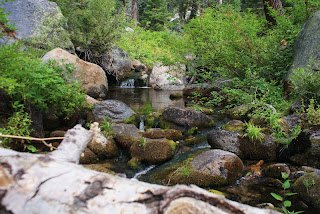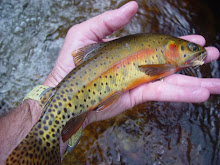It's been a while since I have added a blog entry. There is a very good reason for that - I haven't been fishing since my Brookiebum trip to Shenandoah National Park in June.
After I hiked my first 14er for my 40th birthday in 2007, I had been dreaming of the highest 14er in the lower 48 for my 45th. This trip to California was to climb Mt. Whitney (14,508 feet) on my 45th birthday but I figured, I'm here, I might as well fish.
I made a trip to California in 2010 to (successfully) complete the California Heritage Trout Challenge. The only salmonid I struck out on in California was the Paiute cutthroat when I went into the Silver King Creek watershed. After the California golden trout, this was the species I most wanted to catch. I caught several beautiful, invasive rainbow trout in Silver King but I was unable to add the fish I most wanted to catch. I remember when I left California I was extremely disappointed because I didn't know if I would ever make a return trip.
When I won the Mt. Whitney lottery earlier this year, the first day trip to plan was to catch the Paiute cutthroat. This time I would take the chance out of it and hike into a stream I new contained the elusive Paiute. It is a stream outside of their native watershed but I knew this stream contained only Paiute cutthroat.
So the day came and I found myself in the campground at Devil's Postpile National Monument. Working on only three hours of sleep from the drive from Las Vegas, I got a late start on the trail - an hour later than I planned. The hike would be seven miles in on trail, then another 1+ miles of off-trail bushwhacking. An early start was much needed.
After crossing the Middle Fork of the San Joaquin, it was a short climb to the top of the first ridge. While climbing, I crossed the John Muir Trail...
The first two hours of the hike out was a continuous climb. Finally I reached the pass and could see my final destination in the distance. If you can see the small granite knob about halfway up the right side of this photo, the trailhead was down the back side of that small ridge.
After I hiked my first 14er for my 40th birthday in 2007, I had been dreaming of the highest 14er in the lower 48 for my 45th. This trip to California was to climb Mt. Whitney (14,508 feet) on my 45th birthday but I figured, I'm here, I might as well fish.
I made a trip to California in 2010 to (successfully) complete the California Heritage Trout Challenge. The only salmonid I struck out on in California was the Paiute cutthroat when I went into the Silver King Creek watershed. After the California golden trout, this was the species I most wanted to catch. I caught several beautiful, invasive rainbow trout in Silver King but I was unable to add the fish I most wanted to catch. I remember when I left California I was extremely disappointed because I didn't know if I would ever make a return trip.
When I won the Mt. Whitney lottery earlier this year, the first day trip to plan was to catch the Paiute cutthroat. This time I would take the chance out of it and hike into a stream I new contained the elusive Paiute. It is a stream outside of their native watershed but I knew this stream contained only Paiute cutthroat.
So the day came and I found myself in the campground at Devil's Postpile National Monument. Working on only three hours of sleep from the drive from Las Vegas, I got a late start on the trail - an hour later than I planned. The hike would be seven miles in on trail, then another 1+ miles of off-trail bushwhacking. An early start was much needed.
After crossing the Middle Fork of the San Joaquin, it was a short climb to the top of the first ridge. While climbing, I crossed the John Muir Trail...
...before entrering the Ansel Adams Wilderness.
It was obvious this area had previously been hit with forest fires but, this June, it wa also hit with a major wind storm. There were downed trees the entire length of the seven miles of trail. The United States Forest Service personnel had done an outstanding job clearing miles of trails! These were not small trees they had to clear, some were four or five feet in diameter!
Regardless, the trail was in excellent shape and the views of this rugged area were amazing.
After crossing the first (low) ridge, I crossed a stream then sarted a nearly two mile climb to the top of the second ridge. The effective use of switchbacks made this climb much easier than it would have been otherwise.
After descending from the pass, I started looking for my first off-trail GPS waypoint. After seven miles (2.5 hours of hiking) it was time to leave the trail. Solo, off-trail hiking in a rugged wilderness is not something I was too keen about doing but I was prepared. I had my GPS (with SPOT communicator), extra batteries, water filter, head lamp, and plenty of food.
The next mile (plus) of hiking was a simple matter of following the GPS waypoints into the mini-canyon section of this stream. It was a fairly uneventful descent until I got to the second from last waypoint, at that point it was clear why my friend had marked this waypoint.
If you look closely at the photo, you can see that the next fifty feet or so was straight down over the rocky point I found myself standing on. Did I mention I was hiking solo? When I hike alone, I try not to take unneccesary risks - this one was necessary! There were Paiute cutthroat down there somewhere and I had gone too far to turn back.
I took my time descending this wall, being very careful with every foot placement.
I successfully descended this obstacle but the reality of it was I would eventually need to climb it to get out!
I put that thought out of my mind because I had one more waypoint to hit and that was where the Paiute cutthroat were located.
I found the last waypoint and, sure enough, I got my first look at my "white whale" - the Paiute cutthroat.
After watching the cutties swim about in every little pocket and pool, it was time to string up the rod and try to add this species to my life list.
With the obvious healthy population in this stream, the first pool I decided to cast a fly produced my first Paiute cutthroat.
Fishing in this stream was much like fishing in Golden Trout Creek - overpopulated. I landed 3-4 cutts in every pool or pocket of water. The population is doing great!
In the short time I fished, I landed probably close to 30 little Paiute cutthroat.
After catching my share of Paiutes, I decided to have lunch before I started the climb out. What a great place to have lunch!
With the daunting hike out ahead of me; I topped off my hydration bladder, packed my rod, and started heading up/out.
I climbed up the rock wall and continued the mile plus climb up to the trail. The bushwhacking was a simple matter of backtracking the GPS waypoints because (as you can see) there was NO trail.
If I had remembered my spool of tippet material I would have stopped to wet a line in this stream as it was absolutely teaming with little rainbows.
It was probably for the better though as my legs were quite fatigued and I still had one more small climb to make.
Finally, nearing the trailhead I could see the area namesake, Devil's Postpile (just because I was there).
When I finally reached the trailhead, my feet were quite sore and my hydration bladder was empty again - I was glad to be back to the campground!
Of all of the native species and sub-species I have chased all over the west, this species (although not in the native watershed) has to be the most difficult to catch. A very difficult solo hike of over 16 miles, including over two miles of off-trail bushwhacking. This, and the fact it has always been one of my most sought after species, also makes this one of my most rewarding adventures.
Now that I have addded my "white whale" to my life list, I now have only three cutthroat species to complete the list: Coastal, Whitehorse basin, and the "Alvord".
Chris




























































